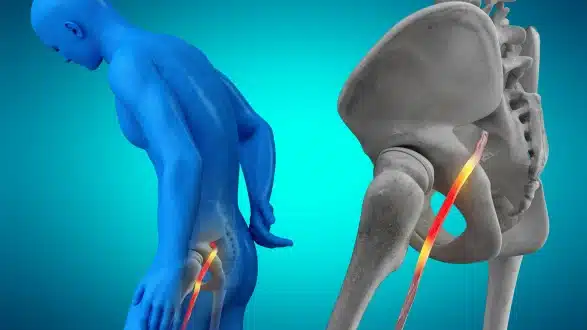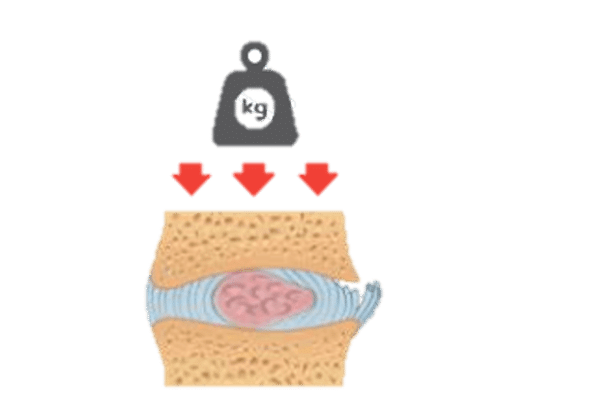Request Appointment
Enter your details and we will be in touch with you shortly;
Or call
8655885566
between 8 am and 8 pm.

A pain in the back , neck or buttock that radiates to the leg or arm

Sciatica can be described as any sort of discomfort along the course of the sciatic nerve or the lumbosacral nerve roots. Ordinary lower back pain or ordinary leg pain, etc., which are often diagnosed as sciatica based on certain patient complaints and examination.
The sciatic nerve, which descends from nerve roots L4 to S3 and may be up to 2 cm in thickness, is the largest in the human body. Lumbar pain increases when twisting, bending, or making flexion movements at the back, coughing, etc. A personalized plan, integrating sciatica relief therapy and sciatica relief treatment, will help you achieve long-term sciatic nerve pain relief while addressing both inflammation and nerve compression.
The sciatic nerve is involved in motor function to hamstrings as well as lower extremity adductors, with related effects to the calf muscles and anterior lower leg muscles, besides some of the muscles in the feet. Sensory impulses from its branches innervate the back and side of the lower leg and the sole. It mostly involves inflammation that leads to irritation of the nerve; hence, most sciatica is a result of this cause. However, when applied directly to the nerve, it might cause severe motor suffering, which should be accompanied by immediate and complete diagnostic procedures.
After the immediate diagnosis, effective sciatica treatment is required. This often takes a two-pronged approach to deal with pain and also regain its functioning. This includes sciatica therapy options like physical therapy, spinal decompression therapy, and chiropractic care.
Sciatica is a general term that pertains to pain in the region served by the sciatic nerve, which usually affects one half of the body. Understanding the different types helps in determining the right sciatica treatment plan and managing the condition effectively.
This type develops without any apparent cause and also is not long-lasting; rather, it may last for a few days to a few weeks at most. It is often a consequence of lumbar disc herniation or muscle strain. Most cases improve with non-surgical sciatica treatment options like rest, medications, and physical therapy for sciatica.
According to the description, pain that lasts for a period longer than 8 weeks is described as chronic. It often requires long-term sciatica therapy, including lifestyle modifications such as sciatica stretches and exercises.
It is also possible for the pain to switch between the two legs, though this is quite uncommon. This is a more complex underlying issue and needs careful pain management for sciatica.
Bilateral lower limb pain is rare and may be a sign of stenosis of the canal or discopathy. Treatment may involve nerve decompression, spinal decompression therapy, or even surgical consultation.
Sciatica is common in individuals between thirty and fifty years of age, those who are not physically active, either due to their work or personal choice, have poor posture, and those who lift heavy loads at work.
Most patients benefit from sciatica treatment options that do not require surgery. These include hot and cold therapy for sciatica, acupuncture for sciatica pain, and muscle relaxants for sciatic pain, depending on individual symptoms.
Sciatica is quite common and affects almost 40% of adults. Sciatica pain traverses through the sciatic nerve, which starts in your lower back and extends to run through your hips, buttocks, legs, and feet on both sides. This is the most distinctive sign of sciatica pain. The nerve pain primarily occurs due to irritation of the sciatic nerve. A proper sciatica diagnosis and the best sciatica treatment are all that you need to lead a pain-free life.
Before knowing about sciatica relief treatment, you need to understand that no two sciatic pain episodes are similar, as they range from annoying, dull pain to excruciating pain. The sciatic pain is generally felt more severely in your leg than in your lower back.
The symptoms of sciatica are as follows: -
Sciatica starts in the back. However, occasionally, pain may start at the hip or knee, which may not look like sciatica. You may feel isolated symptoms like foot numbness, knee pain, buttock pain, tingling, etc. After prolonged sitting, when the person gets up, they tend to hunch forward.
Mostly, the condition starts as back pain, and when the nerve gets compressed more, and if the back pain is left untreated, then it can progress to sciatica.
 Professional diagnosis required
Professional diagnosis required Chronic, can last for years
Chronic, can last for years Treatable with 4 weeks of QI Spine Therapy
Treatable with 4 weeks of QI Spine TherapyThe most common sciatica cause is a herniated disc (or slipped disc) or a pinched nerve. Due to injury or trauma, the vertebra may slip forward, or discs may weaken over time and as a consequence, the nerves get compressed. However, it is often the gradual outcome of bending, sitting for several years.
Let’s know in detail about Sciatica causes. It can be caused due to different conditions listed below: -
 Professional diagnosis required
Professional diagnosis required Chronic, can last for years
Chronic, can last for years Treatable with 4 weeks of QI Spine Therapy
Treatable with 4 weeks of QI Spine TherapyThere are several methods for sciatica relief treatment. You could follow a few home remedies as a part of sciatica pain treatment to reduce sciatica pain, which are mentioned below: -
Sciatica pain can be managed easily through precise spine rehabilitation, which is the best treatment for sciatica.
After a thorough diagnosis, those movements that cause pain will be assessed. Ergonomic assessment at work and home is done to devise a customized treatment plan.
The sciatica relief therapy includes the first step as pain management by microcurrents (cell repair technology). Based on your movement assessment, you will be advised a few medical movements and ergonomic corrections to ensure that your pain reduces, not only while doing exercise but even after that. The spine doctor works on cell repair, and this helps in bringing the pain down as well as heals your tissues.
The second step of sciatica treatment is managing the root cause using DSA (digital spine analysis) test, i.e, decreasing the spinal load and increasing the muscle strength and loading capacity of the spine.
The third step of sciatica treatment is strengthening your targeted weak muscles.
It might not be possible to prevent sciatica always, as the condition may recur. However, the following key points may help in preventing sciatica and protecting your back.
Sciatica treatment at the right time can prevent you from going through that throbbing pain. You should consider seeking medical help when home remedies or self-care measures fail and your symptoms worsen or persist progressively.
Check for the following signs and seek sciatica pain treatment immediately –
 Professional diagnosis required
Professional diagnosis required Chronic, can last for years
Chronic, can last for years Treatable with 4 weeks of QI Spine Therapy
Treatable with 4 weeks of QI Spine TherapySciatica is often a symptom of severe back pain. The most effective treatment plan can be designed when the diagnosis is accurate. QI Spine’s Digital Spine Analysistechnology accurately pin-points the exact location and nature of damage to the spine.
 Professional diagnosis required
Professional diagnosis required Chronic, can last for years
Chronic, can last for years Treatable with 4 weeks of QI Spine Therapy
Treatable with 4 weeks of QI Spine TherapyDiagnosing the root cause of sciatica is the first step to sciatica relief treatment. The spine doctor will go through your detailed medical history and check your spine, which helps in drawing the diagnosis.
For an accurate Sciatica diagnosis, the following examination will be conducted by your doctor:
QI Spine doctors have over 9000 hours of specialization in treating back and neck conditions. A detailed medical analysis is carried out, including pain history, how pain impacts your nerves, your range of motion, and testing of nerves and muscles.
After the thorough analysis of your sciatica pain doctor will design a personalized sciatica relief therapy for you. The therapy follows the whole patient's journey, and our spine doctors will guide you from the first day of consultation to the post-care. Also, the doctor and you can both track the treatment details over QI Spine’s app. The app also allows you to map your exercise routine, schedule your video consultation or in-clinic appointment, and track your recovery progress.
 Professional diagnosis required
Professional diagnosis required Chronic, can last for years
Chronic, can last for years Treatable with 4 weeks of QI Spine Therapy
Treatable with 4 weeks of QI Spine Therapy


Have a question?
Ask our spine specialists
Who is a QI Spine Specialist?
A QI Spine Specialist is a medical expert with

Dr. Nidhi Sanghvi Shah

Dr. Shital Gaikwad

Dr. Richa Bhatia
9000 hours
of specialisation in treating back and neck conditions
32 hours
of spine physiotherapy specialisation methods in McKenzie concepts, Kinetic control, Neurodynamic solutions, Mulligan’s concepts
500 hours
and 6 months of QI Spine specialisation courses
Yes, walking is generally beneficial for sciatica because it helps to benefit the entire body and can work well for those who suffer from sciatic nerve pain. It reduces congestive and inflammatory symptoms as well as the pressure exerted on the sciatic nerve. Regular walking is often recommended as part of non-surgical sciatica treatment.
All patients should lie on their side with a pillow between their knees or alternatively lie on their back it with a cushion under the knees. Though these positions help in maintaining the spinal structures and decrease nerve impingement through the night.
Sciatica stretches and exercises through yoga improve flexibility and reduce pressure on the sciatic nerve. Some of the postures include the pigeon pose and child’s pose, and such postures have been known to reduce pain and act as remedies.
Some of the effective home exercises for sciatica are pelvic tilts, knee-to-chest stretches, and seated spinal twists. These help reduce tension lying in the lower part of the back and helps strengthen muscles of the abdomen, which supports the spine.
Quick relief may come from hot and cold therapy for sciatica, over-the-counter pain medications, gentle stretching, or muscle relaxants for sciatic pain. In more severe cases, epidural steroid injections for sciatica may offer short-term relief.
Sciatica is the pain that radiates along the path of sciatic nerve, which is the largest nerve in your body. Usually, pain develops on one side of the body, which typically originates in the lower back and extends to the legs.
Basically, sciatica pain happens due to an injury or irritation to the sciatic nerve. It is commonly caused due to a slipped disc or herniated disc that puts pressure on the nerve root. When a nerve in your lower back gets compressed, irritated, or pinched, it results in sciatica.
A typical episode of sciatica may last for several weeks. Sciatica can be acute or chronic. An acute episode may last between 1-2 weeks and gets resolved in a few weeks.
DSA evaluates your spine to find out the exact percentage of load on your spinal muscles and then helps in creating a precise individual treatment plan, which targets strengthening your muscles.
Typical symptoms are low back pain, leg pain, buttock pain, weakness, numbness, pain with movement, and decreased range of motion. Check out the sciatica causes also to understand better.
Avoid sitting or lying down for a long period of time. Move frequently even if it hurts, as it helps you to get better faster.
Continue doing your normal day-to-day activities as much as possible.
Place a firm cushion or pillow under your knees while lying on your back and place it in between your knees when sleeping on our side.
If the person works under severe physical stress environment then, the chances of recurrence are high. However, many factors are responsible for whether a person will have sciatica occurrence more than once. Sciatica may re-occur if the spinal disc that first contributed to sciatica is severely damaged. If the disc is damaged more then, more likely it will re-herniate and result in sciatica again.